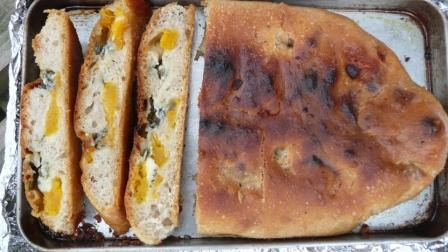This stuffed bread makes wonderful picnic food as the filling holds itself in place allowing you to eat it with just hands – and a napkin for the fastidious. We took it for a packed lunch while decorating our new apartment and it was much more sustaining than the bag of Doritos (T’s choice, not mine) we’d munched on the day before: it didn’t stain everything orange either, which is a bit of a bonus when you’re trying to paint everything in shades of white.
It’s a handy vegetarian addition to my picnic / packed lunch recipe repertoire.
 Butternut squash and blue cheese bread
Butternut squash and blue cheese bread
*Any creamy blue cheese such as dolcelatte, gorgonzola etc. will do just as well; here I happened to have some Stilton left over from Christmas haunting the freezer.
Gently stretch out the ball of dough on an oiled swiss roll tin – or toaster oven tray – coaxing it towards the edges. It will relax and stretch further so don’t be anxious about this.
Strew the cheese and squash over the surface of the dough, padding the filling towards the edges. Scatter with the shredded sage, then make a papoose by bringing the long edges of the dough to meet over the top and press them together to seal so the cheese doesn’t leak out when it melts in the oven. At this point it will not look at all promising, but have no fear. Sprinkle chopped nuts, if using, across the seam and press them lightly into the dough so they stick.
Bake in a hot oven (450F, 200C, Gas 7) for about 30 minutes, basting halfway through with a little olive (or hazelnut/walnut if you have it) oil for a delicately crunchy crust: cover the nuts with a strip of foil if they’re browning too fast (or blackening in my case, one hazard of using a toaster oven).
Cool, loosen the bottom with a palette knife, then cut into slices or wrap the whole in foil to slice later.
The sage makes a delicous ménage à trois with the blue cheese and squash, which the richly nutty pecans turn into a veritable orgy of flavours, or for an enjoyable alternative you could try swinging with rosemary and walnuts instead: a bit of gustatory promiscuity can produce some pretty interesting offspring.
For a punchy packed lunch just add a handful of rocket leaves and for a picnic add whatever you like, but the way this British summer’s been shaping up you’ll be needing a blanket, windbreak, hot water bottle – and your head examined: it’s blowing a gale as I type this.
A note to British readers: some branches of Waitrose sell frozen butternut squash, which is pretty darn handy for this recipe as it’ll cook in the microwave in 4 minutes – and there’s no skin to deal with!
This post is my first-ever entry for the WTSIM… summer picnic blogging event.
























